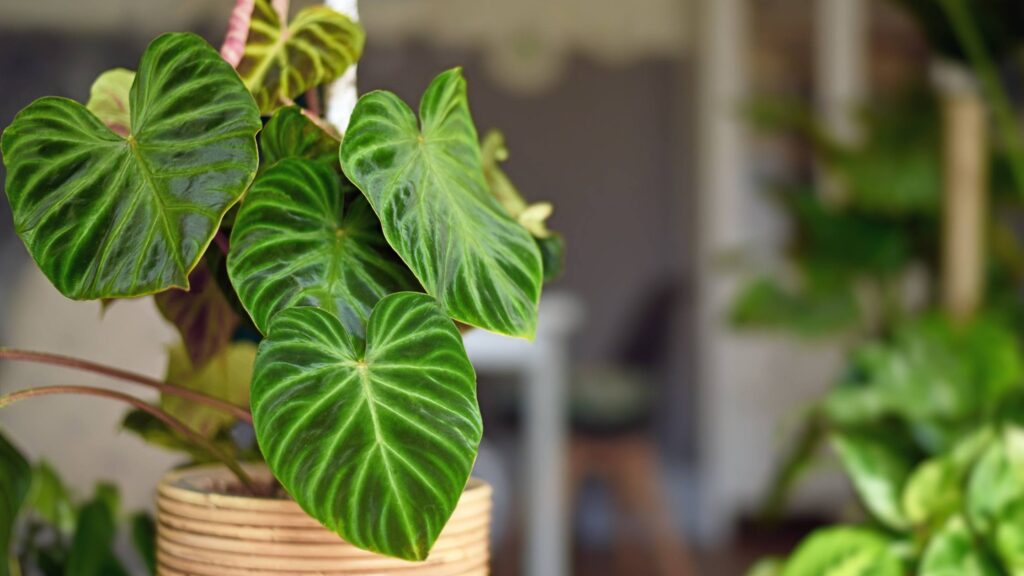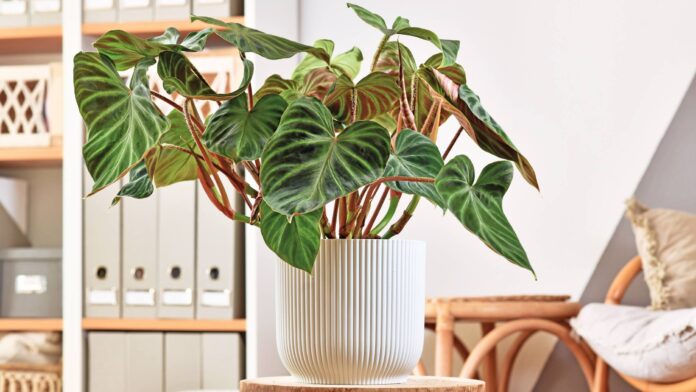Table of Contents
The Philodendron Dark Cardinal, with its stunning transition from deep burgundy to almost black foliage, stands as a testament to the diversity and beauty within the Philodendron genus. This comprehensive guide dives deep into everything you need to know about caring for, propagating, and troubleshooting common issues with your Philodendron Dark Cardinal.
Introduction
The Philodendron Dark Cardinal captivates with its glossy, broad leaves that elegantly shift in color as they mature. This hybrid, known for its compact and robust growth, adds a touch of the tropics to any indoor setting. Despite its exotic appearance, it’s surprisingly low-maintenance, making it a beloved choice for both novice and experienced plant enthusiasts.
What Makes Philodendron Dark Cardinal Unique
Its allure lies not just in its striking color transformation but also in its growth habit and adaptability to indoor environments. Unlike its vining cousins, the Philodendron Dark Cardinal boasts a self-heading posture, allowing for a dense, bushy appearance that fits beautifully in interior landscapes.
Understanding the Botanical Profile
Belonging to the Araceae family, the Philodendron Dark Cardinal thrives under the canopy of tropical forests in its hybridized form. This background gives clues to its care; it favors warm, humid conditions with dappled light, mimicking its native habitat.
Essential Care
Caring for this plant involves understanding its basic needs, from light requirements to soil preferences.
Optimal Lighting Conditions
Bright, indirect light fuels the Philodendron Dark Cardinal’s vibrant foliage without risking leaf burn. A spot near a window with sheer curtains often provides the ideal lighting scenario.
Soil and Watering Needs
A well-draining, nutrient-rich soil supports its growth while preventing the dread of root rot. When it comes to watering, allow the top few inches of soil to dry out before thoroughly soaking the soil again. This method encourages deep root growth and prevents overwatering.
Temperature and Humidity Essentials
Warm temperatures and high humidity reflect its tropical origins. Keeping the air around your Philodendron Dark Cardinal moist will promote lush, healthy growth. Consider using a humidifier or placing your plant on a pebble tray to increase humidity levels.
Fertilization Techniques
A balanced, slow-release fertilizer applied during the growing season supports vibrant growth. However, it’s crucial to follow recommended dosages to avoid fertilizer burn.
Propagation
Propagating this philodendron can be a rewarding experience, offering a way to expand your collection or share with fellow plant lovers.
Step-by-Step Guide to Stem Cuttings
Choose a healthy stem, cut below a node, and place in water or moist soil. With patience, roots will develop, ready for potting.
Water vs. Soil Propagation: What Works Best
While both methods are effective, water propagation allows for visible root growth monitoring, making it a popular choice for beginners.
Pruning and Maintenance Tips
Regular pruning maintains its shape and encourages fuller growth. Remove any yellowing or damaged leaves to keep your plant looking its best.
When and How to Prune
Best done in the growing season, pruning should focus on removing old foliage and shaping the plant to your liking.
Repotting
Though a slow grower, your Philodendron Dark Cardinal will eventually need repotting to continue thriving.
Signs It’s Time to Repot
Roots peeking out of drainage holes or a noticeable slowdown in growth indicate it’s time for a larger home.
How to Choose the Right Pot and Soil
Opt for a pot slightly larger than the current one with adequate drainage. A fresh, well-draining potting mix will rejuvenate your plant’s growth.
Dealing with Pests and Diseases
Fortunately, Philodendron Dark Cardinals are relatively resistant to pests and diseases. Regular inspections and prompt treatment can prevent most issues.
Common Pests to Watch Out For
Mealybugs, spider mites, and thrips are occasional nuisances, easily treated with insecticidal soap or neem oil.
Preventing and Treating Diseases
Overwatering is a common culprit behind diseases. Ensure your potting mix is well-draining and allow the soil to dry between waterings.
Landscaping
While primarily an indoor plant, the Philodendron Dark Cardinal can also make a stunning addition to shaded outdoor gardens in warm climates.

Indoor vs. Outdoor Planting
Adaptable to both environments, it requires protection from direct sunlight and extreme temperatures when placed outdoors.
Companion Plants for Philodendron Dark Cardinal
Pair with other shade-loving tropicals like ferns or peace lilies for a lush, jungle-like feel in your home or garden.
Troubleshooting Common Issues
Addressing common care mistakes early can prevent most problems with your Philodendron Dark Cardinal.
Yellowing Leaves and Other Concerns
Improper lighting, over or underwatering, and nutritional deficiencies are common issues, easily rectified with slight care adjustments.
Addressing Root Rot and Overwatering
Ensuring a well-draining soil mix and pot, along with careful watering practices, can prevent these serious issues.
FAQs: Expert Answers to Your Questions
Q: How often should I water my plant?
Water when the top 2-3 inches of soil become dry to the touch. This typically means watering approximately every 1-2 weeks, though this can vary based on your home’s humidity and temperature. Check the soil moisture before watering to prevent overwatering.
Q: Can it thrive in low light?
While it prefers bright, indirect light to maintain its vibrant coloration, it can survive in low-light conditions. However, expect slower growth and less intense leaf coloring. For optimal health and appearance, place it in a location that receives indirect sunlight for most of the day.
Q: What is the best fertilizer?
A balanced, water-soluble fertilizer with an NPK ratio of 20-20-20 or similar is ideal. Apply it every 4-6 weeks during the growing season (spring through summer) and reduce to every 8 weeks in the fall and winter. Always follow the product’s instructions to avoid over-fertilization.
Q: How do I know if it needs repotting?
Signs include roots growing out of the drainage holes, water draining too quickly, or the plant looking top-heavy and outgrowing its pot. Typically, repotting every 2-3 years should suffice.
Q: Is it toxic to pets?
Yes, it is toxic to pets. It contains calcium oxalate crystals that can cause oral irritation, pain, and swelling of the mouth, tongue, and lips, vomiting, and difficulty swallowing if ingested. Keep it out of reach of curious pets.
Q: How can I increase humidity for my indoor plant?
To increase humidity, you can use a humidifier, place a pebble tray filled with water beneath the plant, or group it with other plants to create a microclimate with higher humidity. These methods help mimic the tropical conditions it thrives.
Conclusion:
The Philodendron Dark Cardinal is not just a plant; it’s a statement piece that adds a touch of drama and sophistication to any space. With the right care, it’s a rewarding, resilient addition to your plant collection, capable of bringing joy for years to come. Remember, the key to a thriving is understanding and mimicking its natural tropical habitat as closely as possible.



